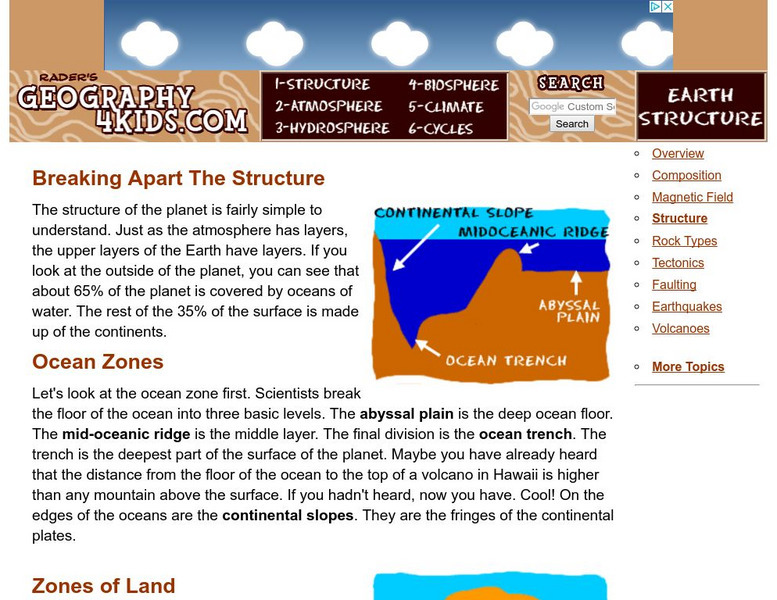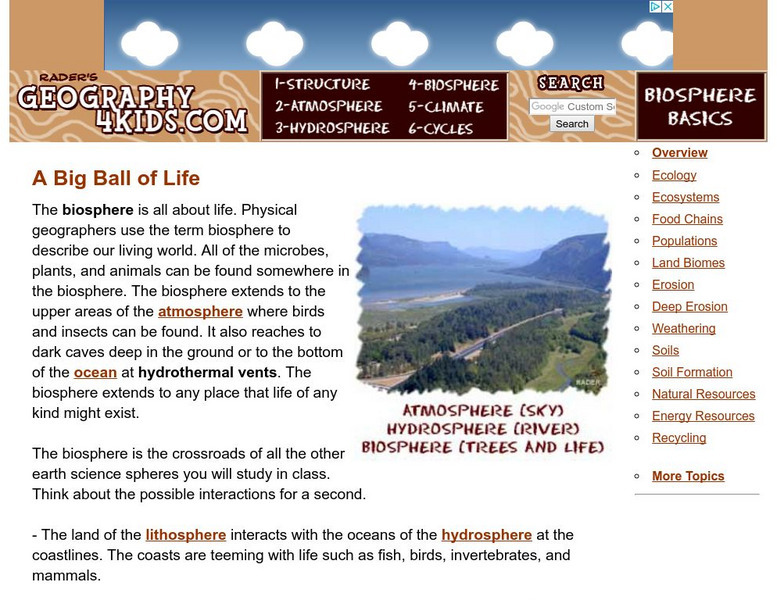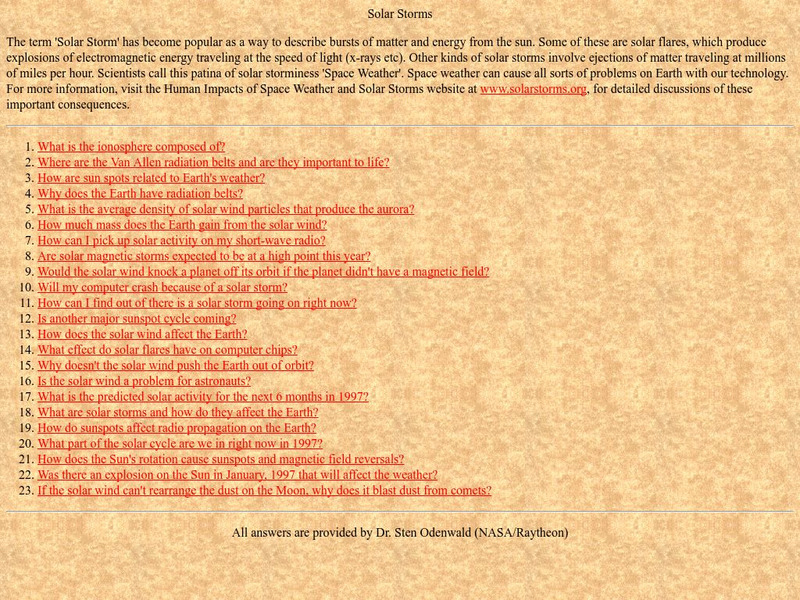Hi, what do you want to do?
The Franklin Institute
The Franklin Institute: Earth Bowl
This activity from The Franklin Institute demonstrates the layers of the earth using gelatin, pudding, graham crackers, and a few other items. The students actually construct a representation of the earth that they can eat.
The Franklin Institute
The Franklin Institute: Clay Crash
Employ this lesson plan from The Franklin Institute to demonstrate plate tectonics and the effects. This is really just a short demonstration that could be incorporated into your existing lesson plan.
Enchanted Learning
Enchanted Learning: Zoom Astronomy
Where is our Solar System? How far away is the sun? What makes up the sun? Find out all you want to know about our solar system. This is a comprehensive on-line site about space and astronomy. Check out all of the excitement!
Geography 4 kids
Geography4 kids.com: Breaking Apart the Structure
Take a look at the structure of the Earth's surface to its core.
Geography 4 kids
Geography4 kids.com: A Big Ball of Life
Gain knowledge of the biosphere highlighted in this resource. The biosphere includes all parts of the living world.
Ducksters
Ducksters: Science for Kids: Earth's Atmosphere
Kids learn about the science of the Earth's Atmosphere. Carbon dioxide, Oxygen, Nitrogen and more make up clouds and weather.
Ducksters
Ducksters: Earth Science for Kids: Topography
Kids learn about the Earth science subject of topography including features such as landforms, elevation, latitude, longitude, and topographical maps.
Ducksters
Ducksters: Earth Science for Kids: Weather: Tornadoes
Explore tornadoes on this website! Kids learn about tornadoes including how they form, characteristics, types including supercell and waterspout, categories, and fun facts.
Ducksters
Ducksters: Earth Science for Kids: Tsunamis
Investigate tsunamis including what causes them such as earthquakes, where they occur, why they are dangerous, and what happens during a tsunami event on this website.
Ducksters
Ducksters: Earth Science for Kids: Weather Forecasting and Meteorology
On this website, students can learn about weather forcasting and meteorology including cold and warm fronts, high and low pressure systems, fun facts, and technology.
Ducksters
Ducksters: Physics for Kids: Electricity in Nature
Kids learn about electricity in nature the science of physics including lightning, animals, the human body, the Earth, and static electricity.
NASA
Climate Kids: 10 Interesting Things About Earth
Discover 10 interesting things about Earth, including its shape, its seasons, rotation, Ice Ages, the Atacama Desert, gravity, changing sea levels, and the Moon.
NASA
Nasa: Image Science Center: Ask the Space Scientist Earth
Site from NASA contains a collection of 91 questions pertaining to the Earth's atmosphere, magnetic field, ionosphere, rotation and origin of life.
ClassFlow
Class Flow: Planets and Stars
[Free Registration/Login Required] In this flipchart students will learn about the planets and stars.
ClassFlow
Class Flow: Rock and Earth
[Free Registration/Login Required] The parts of the earth, classifying minerals, and layers of rock are described in this flipchart.
ClassFlow
Class Flow: Rock Record Relative Dating
[Free Registration/Login Required] This flipchart presents information about how the earth was formed. It discusses methods of dating the layers of the earth's surface. Assessment questions are included.
ClassFlow
Class Flow: Solar System
[Free Registration/Login Required] This flipchart guides online research on a study of our solar system and links the teacher to a WebQuest activity.
ClassFlow
Class Flow: Space Solar System
[Free Registration/Login Required] In this lesson students will compare and contrast the attributes of star, star patterns and planets. Students will also have the opportunity to review facts about each planet and then complete various...
Other
National Pollutant Inventory: Background Information
This site focuses on water and air pollution in Australia, with a brief mention of sea breezes.
ClassFlow
Class Flow: Weathering
[Free Registration/Login Required] This flipchart introduces the concepts of weathering and erosion. Both physical and chemical weathering, and their causes are discussed. Video is embedded. The flipchart also has assessment questions...
ClassFlow
Class Flow: Continents of the World
[Free Registration/Login Required] This flipchart is devoted to identifying, locating, and learning facts about the 7 continents. It contains interactive maps, facts, and a short video at the end.
ClassFlow
Class Flow: Fossils
[Free Registration/Login Required] This flipchart introduces students to the different types of fossils.
ClassFlow
Class Flow: The Earth's Plates
[Free Registration/Login Required] This flipchart introduces students to the theory of plate tectonics. Continental drift theory and Pangaea are also discussed.
ClassFlow
Class Flow: Anatomy of the Sun
[Free Registration/Login Required] This is a middle school science lesson on the Sun. Activote questions are included. Submitted for Lucinda Schlotterback, in Sarasota County, FL.



























